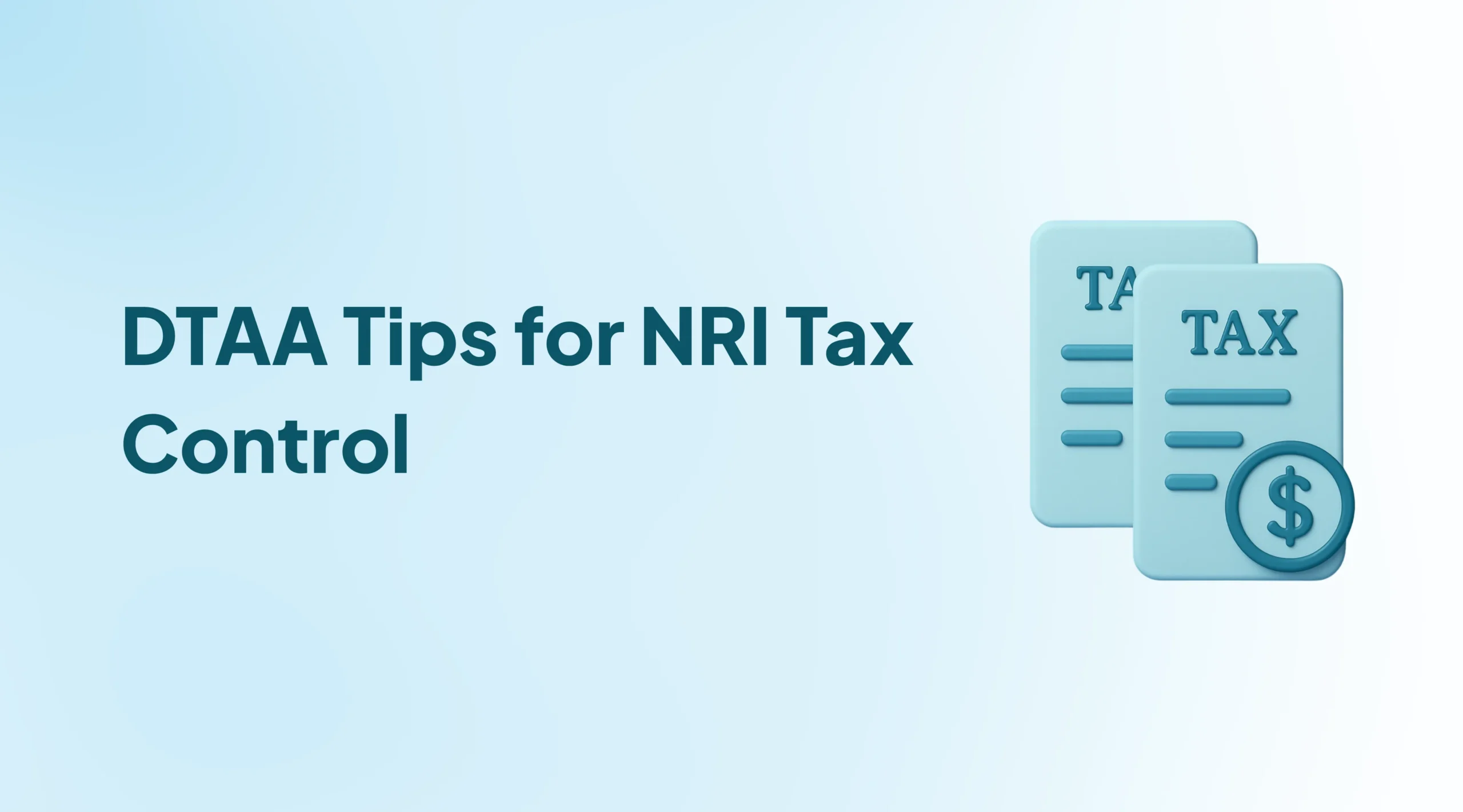Non-Resident Indians (NRIs) often face the daunting challenge of double taxation, where the same income is taxed both in India and abroad. This issue can significantly impact your financial health and complicate your tax filings. Fortunately, the Double Taxation Avoidance Agreement (DTAA) provides a solution. This article breaks down six actionable DTAA tips for 2025 to help NRIs avoid paying extra taxes. By understanding and utilizing DTAA, you can ensure that you are not taxed twice on the same income, thereby optimizing your financial planning.
What is DTAA? Understanding Double Taxation Avoidance Agreement
Double Taxation Avoidance Agreement (DTAA) is a treaty signed between two or more countries to help taxpayers avoid paying taxes twice on the same income. For NRIs, this means that if you earn income in India and are also liable to pay taxes in your country of residence, DTAA ensures that you do not end up paying taxes on the same income in both countries.
Double taxation occurs because different countries have different tax laws. For instance, if you are an NRI working in the USA, you might have to pay taxes on your global income in the USA and also in India if you have income sources in India. DTAA helps mitigate this by providing a framework for tax relief.
Example Scenario: Imagine you are an NRI living in the UK and earning rental income from a property in India. Without DTAA, you would have to pay taxes on this rental income in both the UK and India. However, with DTAA, you can claim relief and avoid being taxed twice.
Benefits of DTAA for NRIs
- Avoid Paying Tax Twice: The primary benefit of DTAA is that it helps NRIs avoid paying taxes on the same income in two different countries. This can result in significant tax savings.
- Lower Withholding Tax Rates: DTAA often provides for lower withholding tax rates on various types of income such as dividends, interest, and royalties. This means that less tax is deducted at source, increasing your net income.
- Credit Method vs Exemption Method: DTAA provides two methods for tax relief: the credit method and the exemption method. Under the credit method, you can claim a credit for the taxes paid in one country against the taxes payable in another country. Under the exemption method, certain types of income are exempt from tax in one of the countries.
- Reduced TDS on Interest/Dividends: DTAA can also help reduce the Tax Deducted at Source (TDS) on interest and dividends earned in India. This can be particularly beneficial for NRIs who have investments in India.
6 Key DTAA Tips to Avoid Double Taxation
Tip 1: Know Your Residential Status
Determining your residential status is crucial for understanding your tax liability in India. As per Indian tax laws, an individual is considered a resident if they stay in India for 182 days or more in a financial year. NRIs, on the other hand, are those who do not meet this criterion.
Your residential status determines the taxability of your global income. For instance, if you are a resident, your global income is taxable in India. However, if you are an NRI, only the income earned or accrued in India is taxable.
Tip 2: Identify Relevant DTAA Country Agreement
India has a vast network of DTAA agreements with over 90 countries. It is essential to identify the specific DTAA agreement between India and your country of residence. You can find the text of these agreements on the websites of the Central Board of Direct Taxes (CBDT) or the Reserve Bank of India (RBI).
Tip 3: Understand the Tax Relief Method Used
DTAA provides two primary methods for tax relief: the credit method and the exemption method. Under the credit method, you can claim a credit for the taxes paid in one country against the taxes payable in another country. This method ensures that you do not pay more taxes than the higher of the two tax rates.
Under the exemption method, certain types of income are exempt from tax in one of the countries. This method is beneficial if the tax rate in one country is significantly lower than the other.
Tip 4: Obtain Tax Residency Certificate (TRC)
To claim DTAA benefits, it is mandatory to obtain a Tax Residency Certificate (TRC) from the country where you are a tax resident. The TRC serves as proof of your tax residency and is required to avail of the benefits under DTAA.
You can obtain a TRC from the tax authorities in your country of residence. The certificate should include your name, status as a resident, tax identification number, and the period for which the certificate is valid.
Tip 5: Report Foreign Income Correctly in India
Even if your foreign income is exempt from tax in India under DTAA, it is essential to disclose it in your Income Tax Return (ITR). Failure to report foreign income can result in penalties and legal complications.
Tip 6: Consult a Tax Advisor for Complex Cases
Taxation can be complex, especially for NRIs with income sources in multiple countries. Consulting a tax advisor can help you navigate the intricacies of DTAA and ensure that you are compliant with the tax laws in both countries.
A tax advisor can provide personalized advice based on your specific situation and help you optimize your tax planning. This is particularly important for high-value investments and complex financial portfolios.
Example: How DTAA Works for an NRI in USA/UAE/UK
Let’s consider an example to illustrate how DTAA works for an NRI living in the USA. Suppose you are an NRI earning rental income from a property in India. Without DTAA, you would have to pay taxes on this rental income in both the USA and India.
However, with DTAA, you can claim a credit for the taxes paid in India against the taxes payable in the USA. This ensures that you do not pay more taxes than the higher of the two tax rates.
Common DTAA Provisions for Major Countries:
- USA: The DTAA between India and the USA provides for lower withholding tax rates on dividends, interest, and royalties. It also includes provisions for the credit method of tax relief.
- UAE: The DTAA between India and the UAE provides for the exemption method of tax relief for certain types of income. It also includes provisions for lower withholding tax rates.
- UK: The DTAA between India and the UK provides for both the credit and exemption methods of tax relief. It also includes provisions for lower withholding tax rates on dividends, interest, and royalties.
How to Claim DTAA Benefits While Filing Taxes
To claim DTAA benefits while filing your taxes, you need to include your Tax Residency Certificate (TRC) and Form 10F. Form 10F is a declaration form that includes details such as your name, address, tax identification number, and the period for which you are claiming DTAA benefits.
It is also essential to coordinate with your Chartered Accountant (CA) and bank to ensure that the correct amount of tax is deducted at source. This can help you avoid TDS on interest and dividends earned in India.
DTAA Countries with India
India has DTAA agreements with over 90 countries. Some of the major partner countries include the USA, UK, UAE, Singapore, Canada, and Australia. You can find the official list of DTAA countries on the websites of the CBDT or RBI.
FAQs on DTAA for NRIs
What is DTAA in simple words?
DTAA, or Double Taxation Avoidance Agreement, is a treaty signed between two or more countries to help taxpayers avoid paying taxes twice on the same income.
Is TRC mandatory?
Yes, obtaining a Tax Residency Certificate (TRC) is mandatory to claim DTAA benefits. The TRC serves as proof of your tax residency and is required to avail of the benefits under DTAA.
Can NRIs avoid all taxes in India?
No, NRIs cannot avoid all taxes in India. However, DTAA can help NRIs avoid paying taxes twice on the same income and reduce their overall tax liability.
How to avoid TDS on NRO account?
To avoid TDS on an NRO account, you need to submit your Tax Residency Certificate (TRC) and Form 10F to your bank. This will help you claim DTAA benefits and reduce the TDS on interest earned in your NRO account.


0 Comments